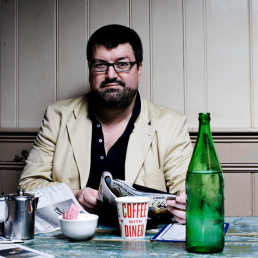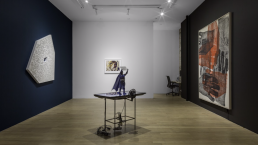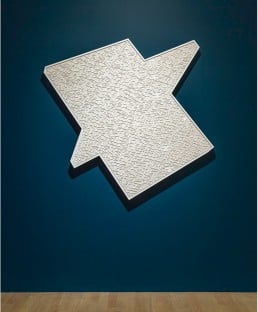Articles and Features:
Group Exhibition"Ideal Contagion"
bitforms gallery - New York
"Ideal Contagion gathers work by artists who use the latest digital knowhow to reject speed and the illusion of many-to-many communication in favor of slower, reflective, highly personal artistic explorations."

| Christian Viveros-Fauné | Kulchur Vulture |
Viveros-Fauné is Artland’s inaugural Chief Critic and the contributor of this regular column. Based in New York City, he writes primarily about exhibitions and the cultural landscape there. His articles also often feature Artland’s revolutionary and market leading Artland 3D, virtual exhibition tours that enable the viewer to pay compelling virtual visits to actual exhibition spaces in support of the texts. This edition visits bitforms gallery in New York for its summer group exhibition, ‘Ideal Contagion’.
In July, group shows and summer colds spread like Kylie Jenner memes. How fitting, then, that a particularly hardy strain of art sampleritis should affect a gallery well known for new media work. Thankfully, this exhibition is all antibodies. Titled “Ideal Contagion,” the display takes the disruptive, data-spreading, 4chan-viral aspect of new technologies and turns it on its contemplative head.
Organized by independent curator and poet David Hunt, “Ideal Contagion” gathers work by artists who use the latest digital knowhow to reject speed and the illusion of many-to-many communication in favor of slower, reflective, highly personal artistic explorations. Or, as the curator writes in the gallery press release, the show’s artists cultivate an attitude towards technology that is “inscribed on, or within, the artist’s own body, buried bone-deep, etched like an algorithmic scrimshaw into the far recesses of his or her own mind.” To paraphrase 1970s video pioneer John Baldessari: newfangled tools only come into their own when they can be used with the ease of a pencil.
Featuring the work of Barry X Ball, Richard Dupont, Peter Gronquist, Lynn Hershman Leeson, John Kessler and Ted Lawson, “Ideal Contagion” takes its cues from works of art that prize an old-school dialogue with history. The exhibition’s concerns runs largely toward the classical, the modernist, the post-modernist and the cyber cutting-edge. The fact that it skews demographically toward baby boomers and Gen Xers signals a faith in time-tested genres and categories—among them, landscape, body art, appropriation—that have yet to infect the adolescent body of today’s boosterish digital art discourse.



Take Barry X Ball. An artist who embodies tech-augmented classicism, his reinterpretation of 19th century Italian sculptor Medardo Rosso’s Une Conversation (1892-99) in cotton-candy-hued Iranian onyx doesn’t just update the original homely sculpture in plaster, it regenerates the Italian’s enigmatic ideal of volatile volumetric images via 3D scans and the aid of CNC (computer numerical control) technology. Ted Lawson, another ace digital fabricator, contributes a pair of wall-mounted mazes made from computer-milled MDF and lacquer: their similarity to circuit boards and engineering diagrams, among other blueprints for knowledge, allude both to 20th century utopian geometric abstraction and the dystopian networks engendered by Big Data in the 21st.
"To paraphrase 1970s video pioneer John Baldessari: newfangled tools only come into their own when they can be used with the ease of a pencil."
Peter Gronquist, a West Coast artist whose multimedia practice includes painting and installation, contributes a digital video of a reflective sheet billowing like laundry on a clothesline. It’s windblown title: a visual history of the invisible (2018). Veteran John Kessler, a master tinkerer well known for exposing the guts of his kinetic works, presents two tottery machine constructions. Their satirical mashup of flatscreens, CCTV cameras, microprocessors and absurd action figures invokes Jean Tinguely’s self-destroying Homage to New York (1960) for the digital age. Then there’s Richard Dupont, an artist who transfers his concerns about biometrics, or the digital mapping of the body, into a pair of machine-assisted oil on canvas paintings of his open palms.
Finally, “Ideal Contagion” includes a photograph of feminist pioneer Lynn Hershman Leeson’s 1970s fictional alter ego, Roberta Breitmore. A picture of the subject’s face marred by perforation lines and plastic surgeon instructions, the four decade old print is an apt reminder of two things this group show makes crystal clear: art’s retooling of technology predates the personal computer, and novelty sure has its limits.
Relevant sources to learn more
Gallery
Bitforms Gallery
Opening year
2001
Opening Times
Wed – Sat
11am – 6pm
Sun
12am – 6pm
Tlf. 212 366 6939
Address
131 Allen Street,
New York, NY 10002
info@bitforms.art